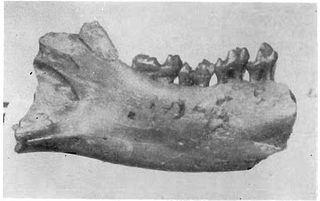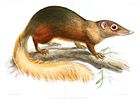
Dentition pertains to the development of teeth and their arrangement in the mouth. In particular, it is the characteristic arrangement, kind, and number of teeth in a given species at a given age. That is, the number, type, and morpho-physiology of the teeth of an animal.
Neoliotomus is a genus of North American mammal from the Paleocene. It existed in the age immediately following the extinction of the last dinosaurs and was a member of the extinct order Multituberculata. It lies within the suborder Cimolodonta and the superfamily Ptilodontoidea. Other than that, its affinities are somewhat unclear.

Aegyptopithecus is an early fossil catarrhine that predates the divergence between hominoids (apes) and cercopithecids. It is known from a single species, Aegyptopithecus zeuxis, which lived around 38-29.5 million years ago in the early part of the Oligocene epoch. It likely resembled modern-day New World monkeys, and was about the same size as a modern howler monkey, which is about 56 to 92 cm long. Aegyptopithecus fossils have been found in the Jebel Qatrani Formation of modern-day Egypt. Aegyptopithecus is believed to be a stem-catarrhine, a crucial link between Eocene and Miocene fossils.

Plesiadapis is one of the oldest known primate-like mammal genera which existed about 58–55 million years ago in North America and Europe. Plesiadapis means "near-Adapis", which is a reference to the adapiform primate of the Eocene period, Adapis. Plesiadapis tricuspidens, the type specimen, is named after the three cusps present on its upper incisors.

Eosimias is a genus of early primates, first discovered and identified in 1999 from fossils collected in the Shanghuang fissure-fillings of Liyang, the southern city of Jiangsu Province, China. It is a part of the family Eosimiidae, and includes three known species: Eosimias sinensis, Eosimias centennicus, and Eosimias dawsonae. It provides us with a glimpse of a primate skeleton similar to that of the common ancestor of the Haplorhini. The name Eosimias is designed to mean "dawn monkey", from Greek eos "dawn" and Latin simius "monkey".
Shoshonius is an extinct genus of omomyid primate that lived during the Eocene. Specimens identified as Shoshonius have been found exclusively in central Wyoming and the genus currently includes two species, Shoshonius cooperi, described by Granger in 1910, and Shoshonius bowni, described by Honey in 1990.

Notharctinae is an extinct subfamily of primates that were common in North America during the early and middle Eocene. The six genera that make up the group contain species that are among the most primitive of the adapiform group, which is one of the most primitive groups of primates. The evolutionary history of this subfamily has been comparatively well documented and has been used to argue for evolutionary gradualism. Though it is generally accepted that adapiforms gave rise to modern day lemurs and lorises, it is not currently known which branch of Adapiformes these living species are most closely related to. Notharctines became extinct in the middle Eocene, most likely because of a combination of factors including climatic change and competition with other North American primates.

Altanius is a genus of extinct primates found in the early Eocene of Mongolia. Though its phylogenetic relationship is questionable, many have placed it as either a primitive omomyid or as a member of the sister group to both adapoids and omomyids. The genus is represented by one species, Altanius orlovi, estimated to weigh about 10–30g from relatively well-known and complete dental and facial characteristics.

Pelycodus is an extinct genus of adapiform primate that lived during the early Eocene (Wasatchian) period in Europe and North America, particularly Wyoming and New Mexico. It is very closely related to Cantius and may even be its subgenus. It may also have given rise to the Middle Eocene Uintan primate Hesperolemur, although this is controversial. From mass estimates based on the first molar, the two species, P. jarrovii and P. danielsae, weighed 4.5 kg and 6.3 kg respectively and were frugivores with an arboreal, quadrupedal locomotion.
The Clarkforkian North American Stage, on the geologic timescale, is the North American faunal stage according to the North American Land Mammal Ages chronology (NALMA), typically set from 56,800,000 to 55,400,000 years BP lasting 1.4 million years.
The Tiffanian North American Stage on the geologic timescale is the North American faunal stage according to the North American Land Mammal Ages chronology (NALMA), typically set from 60,200,000 to 56,800,000 years BP lasting 3.4 million years.

Anaptomorphinae is a pre-historic group of primates known from Eocene fossils in North America and Europe and later periods of Paleocene Asia, and are a sub-family of omomyids. The anaptomorphines is a paraphyletic group consisting of the two tribes Trogolemurini and Anaptomorphini. Anaptomorphine radiation in Wyoming, one of the most detailed records of changes within populations and between species in the fossil record, has provided remarkable evidence of transitional fossils.
Djebelemur is an extinct genus of early strepsirrhine primate from the late early or early middle Eocene period from the Chambi locality in Tunisia. Although they probably lacked a toothcomb, a specialized dental structure found in living lemuriforms, they are thought to be a related stem group. The one recognized species, Djebelemur martinezi, was very small, approximately 100 g (3.5 oz).
The Willwood Formation is a sedimentary sequence deposited during the late Paleocene to early Eocene, or Clarkforkian, Wasatchian and Bridgerian in the NALMA classification.

Anapithecus is a late Miocene primate known from fossil locations in Hungary and Austria. Many Anapithecus fossils come from the site of Rudabánya, in northern Hungary, where Anapithecus lived alongside the ape Rudapithecus. The only species in the genus, Anapithecus hernyaki, is named after Gabor Hernyák, chief geologist of the Iron Ore Works of Rudabánya.

The Wasatch Formation (Tw) is an extensive highly fossiliferous geologic formation stretching across several basins in Idaho, Montana Wyoming, Utah and western Colorado. It preserves fossils dating back to the Early Eocene period. The formation defines the Wasatchian or Lostcabinian, a period of time used within the NALMA classification, but the formation ranges in age from the Clarkforkian to Bridgerian.
Wyonycteris is a genus of small mammals that existed in the late Paleocene and early Eocene epochs. The type species is Wyonycteris chalix, which lived in Wyoming during the Clarkforkian North American Land Mammal Age of the Paleocene and was originally proposed to be an early form of insectivorous bat. Later re-examination of the material has put this alliance in doubt, and the genus has instead been proposed as belonging to the subfamily Placentidentinae, within the family Nyctitheriidae. Similar fossil material of the same time period found in Europe was later discovered and described as new species, Wyonycteris richardi.
Chiromyoides is a small plesiadapid primatomorph that is known for its unusually robust upper and lower incisors, deep dentary, and comparatively small cheek teeth. Species of Chiromyoides are known from the middle Tiffanian through late Clarkforkian North American Land Mammal Ages (NALMA) of western North America, and from late Paleocene deposits in the Paris Basin, France.
Carpodaptes was a genus that encompassed small, insectivorous animals that roamed the Earth during the Late Paleocene. Specifically, Carpodaptes can be found between the Tiffanian and Clarkforkian periods of North America. Although little evidence, this genus may have made it through to the early Eocene. They are known primarily from collections of jaw and teeth fragments in North America, mainly in southwestern Canada and northwestern America. Carpodaptes are estimated to have weighed approximately 53-96 grams which made them a little bigger than a mouse. However small, Carpodaptes was a placental mammal within the order Plesiadapiformes that appeared to have a high fiber diet. This insect-eating mammal may have been one of the first to evolve fingernails in place of claws. This may have helped them pick insects, nuts, and seeds more easily off the ground than with paws or claws. Carpodaptes was thought to only exist in North America but recent discoveries of dentition fragments have been found in China.
Navajovius is an extinct genus of plesiadapiforms that lived during the Paleocene epoch. Plesiadapiforms were small, arboreal mammals that are theorized to be either closely related to primates or dermopterans. Navajovius has only been documented from localities within North America. This genus was officially named in 1921 by Walter Granger and William Matthew and the type specimen is housed at the American Museum of Natural History.














